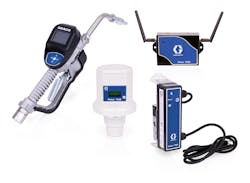Increase shop efficiencies through fluid management
Effective fluid management in fleet vehicle, automotive, heavy truck, and heavy equipment service can reduce costs and improve operational efficiencies, while generating helpful data about dispense history. Complete engineered systems successfully deliver these benefits, as components are designed to work together to deliver the most accurate data possible.
Why choose fluid management?
Effective fluid management systems allow fleets to control expenses by accurately managing their inventory of fluids such as oils, gear lube, coolant, and antifreeze. One benefit offered by fluid management systems is that metering all dispenses ensures the right quantity of the correct fluid is used, avoiding costly mistakes. With this added control, facilities are able to capture additional savings by purchasing fluids in bulk. With an increasing number of vehicles on the road today requiring expensive synthetic oils rather than conventional ones, precise dispense and inventory management is key to keeping costs down.
With the large volume of fluid being stored and dispensed, inventory accuracy and shop efficiencies are critical for expense management. Well-designed fluid management systems provide parts and service managers with the information necessary to order enough fluid at the right time and track volumes of used or wasted fluids. Fluid management systems that allow pin code and work order entry at the meter increase technician productivity as they can stay in their bay and have everything they need at their fingertips. This will result in an increase in both efficiency and the number of vehicles serviced while turning more profit for the service facility.
Another critical reason for implementing a high-quality fluid management system is the ability to recall transaction data. The detailed dispense history provided can help shop managers in visualizing production and discovering patterns or workflow roadblocks in order to improve efficiency. Additionally, having fluid dispense history can provide an audit trail showing the date, time, type of fluid, and how much fluid was dispensed for a particular vehicle, confirming that the correct oil was used or the proper volume replaced.
In short, fluid management systems deliver a range of benefits to fleets, including increased inventory control, greater dispense precision, improved operational efficiency and detailed dispense history.
Factors to consider
There are several factors to consider when looking to update a fluid management system. These include:
- Not all fluids need to be converted at once. Oftentimes customers migrate only one or two oils over to a fluid management system. Typically, customers will choose fluids that are the most expensive and are causing the biggest financial burden due to shrinkage.
Another idea is to start with the mobile roll-around dispense carts or specialty fluids. The wireless capabilities of some systems allow for easy monitoring and tracking of mobile carts and drums. - Migrate one bay at a time. Another phased approach is to convert one bay at a time to fluid management system. This is a great method to understand the true ROI from a single bay being transitioned to fluid management. Fleets can get a comparative analysis on technician productivity and fluid reconciliation for that bay compared with bays not using fluid management.
- Fluid management is easy to install and use. While some may believe that fluid management systems are difficult to install or operate, the wireless fluid management systems available are in fact easier (and less expensive) to install than a wired system. Furthermore, they provide fleets more control than standard written or oral dispense and tracking practices, and greatly simplify processes.
- Expanding fluid management to tank level monitoring will save a fleet money. While installing tank level monitors in a fluid management system isn’t necessary, it does provide huge benefits. Imagine no longer having to call a bulk fluid supplier to schedule a refill of fluids, or having to call a fluid recycling vendor to evacuate used oil before an overfill occurs. With some fluid management systems, uncertain manual processes can be replaced with a reliable automated system that monitors tank levels and schedules deliveries and pickups for the fleet.
- Work with a good lubrication partner. A fleet must trust who they choose to install their fluid management system. Look for suppliers who have years of experience in fluid management and lubrication, and who have dedicated technicians available to provide service, when it’s needed.
Cost savings and improved efficiency
The complete picture offered by top-quality fluid management systems gives insight into how to improve shop efficiencies. With this kind of comprehensive data, fleets can make smart business decisions about inventory and processes.
In combination, the data, system efficiency, and precision dispensing make fluid management critical to managing costs and ensuring success in fleet and municipality vehicle service applications.
Joshua Holmstadt is a senior global product marketing manager for Graco’s Lubrication Equipment Division. Graco Inc. supplies technology and expertise for the management of fluids and coatings in both industrial and commercial applications. Graco designs, manufactures, and markets systems and equipment to move, measure, control, dispense, and spray fluid and powder materials. A recognized leader in its specialties, the Minneapolis-based company serves customers around the world in the manufacturing, processing, construction, and maintenance industries.
About the Author

Joshua Holmstadt
Senior Global Product Marketing Manager
Joshua Holmstadt is a senior global product marketing manager for Graco’s Lubrication Equipment Division.
